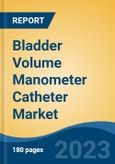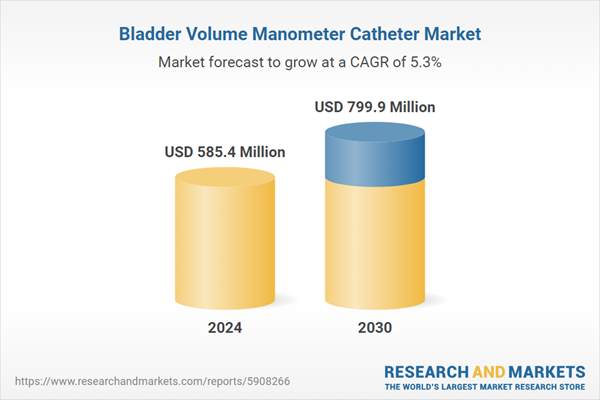Speak directly to the analyst to clarify any post sales queries you may have.
10% Free customizationThis report comes with 10% free customization, enabling you to add data that meets your specific business needs.
The pressure transducer detects changes in pressure within the bladder, while the manometer displays these measurements in milliliters, providing a precise indication of the bladder's volume at any given time. This catheter is particularly valuable in clinical settings where accurate bladder volume measurements are crucial for diagnostic and therapeutic purposes. For example, in patients with urinary retention or those recovering from certain surgical procedures, it is essential to monitor bladder volume to prevent overdistension or to assess the effectiveness of interventions.
Additionally, in cases of neurogenic bladder dysfunction or other urological conditions, regular monitoring of bladder volume can guide treatment decisions and help maintain optimal bladder health. The Bladder Volume Manometer Catheter represents a significant advancement in urological care, offering a direct and precise method for assessing bladder volume. Its use minimizes the risk of complications associated with inaccurate volume measurements, such as catheter-associated infections or bladder overdistension. This specialized catheter plays a critical role in improving patient care and outcomes in the field of urology, providing healthcare professionals with a valuable tool for effective bladder management.
Key Market Drivers
The Rising Prevalence of Urological Disorders
The rising prevalence of urological disorders is a major driving force behind the growth of the Global Bladder Volume Manometer Catheter Market. The increasing incidence of conditions such as urinary incontinence, bladder dysfunction, neurogenic bladder, and overactive bladder (OAB) has fueled demand for precise, reliable, and minimally invasive bladder monitoring solutions. As healthcare systems strive to improve the diagnosis, treatment, and management of these disorders, bladder volume manometer catheters are becoming a critical component in modern urological care. The burden of urological diseases has been steadily rising, driven by factors such as aging populations, lifestyle changes, obesity, diabetes, and neurological conditions.These disorders often lead to urinary retention, incontinence, and incomplete bladder emptying, requiring continuous monitoring of bladder volume and pressure levels. Urinary incontinence is a significant global health concern, with reported prevalence rates varying widely between 9% and 67% across different demographics, healthcare settings, and geographic regions. This variability underscores the growing demand for advanced bladder monitoring solutions, particularly in aging populations and patients with neurological or post-surgical conditions. Common in patients with spinal cord injuries, multiple sclerosis (MS), Parkinson’s disease, and stroke.
Overactive bladder (OAB) syndrome is a chronic, high-impact medical condition that significantly disrupts daily functioning and reduces quality of life for a substantial segment of the population. With an estimated prevalence of 16.5%, OAB presents a growing challenge for healthcare providers and long-term care facilities, driving demand for advanced bladder monitoring and management solutions. As these conditions become more widespread, hospitals, specialty clinics, and home healthcare providers are increasingly adopting bladder volume manometer catheters to enhance patient management.
Many urological disorders, if left untreated, can lead to serious complications such as kidney damage, urinary tract infections (UTIs), and loss of bladder function. Early diagnosis and continuous monitoring of bladder volume are essential to prevent disease progression. Bladder volume manometer catheters help in assessing bladder pressure and capacity, aiding in early-stage detection of detrusor overactivity or underactivity. In post-surgical and ICU settings, these catheters are used to prevent urinary retention complications in patients with neurological impairments. As healthcare providers prioritize preventative care and early intervention, the demand for accurate bladder monitoring solutions continues to rise.
The rising number of hospital admissions related to urological disorders, along with the growing demand for long-term care facilities, has significantly impacted the market for bladder volume manometer catheters. Post-surgical patients and those recovering from prostate surgeries, hysterectomies, or neurological procedures often require precise bladder monitoring.
Patients with spinal cord injuries (SCI) or multiple sclerosis (MS) frequently experience bladder dysfunction, requiring continuous pressure monitoring to prevent complications. Geriatric patients in nursing homes and assisted living facilities are at a higher risk of urinary incontinence and retention, necessitating advanced catheterization solutions. As hospitalization rates rise and long-term care facilities expand, the need for effective bladder volume monitoring devices is growing.
Key Market Challenges
Stringent Safety Regulations
Stringent safety regulations, while essential for ensuring the quality and integrity of medical devices, can pose challenges for market entry and growth, particularly in specialized areas like Bladder Volume Manometer Catheters. These regulations are put in place to safeguard patient well-being, maintain product efficacy, and uphold industry standards. However, their stringent nature can create hurdles for manufacturers and may potentially slow down the introduction of innovative technologies. One of the primary ways in which stringent safety regulations can hamper the market is through the extensive and time-consuming approval process.Manufacturers must meticulously adhere to established protocols, providing comprehensive evidence of the safety and effectiveness of their products. This often involves extensive clinical trials, rigorous testing, and detailed documentation. While these measures are crucial for patient safety, they can lead to prolonged development timelines and significant financial investments. Moreover, meeting stringent safety standards requires a substantial commitment of resources, both in terms of financial investment and skilled personnel. Smaller or newer companies in the market may face challenges in allocating the necessary resources to navigate the regulatory landscape.
This can potentially create a barrier to entry for innovative startups and limit the diversity of offerings in the market. In addition, the costs associated with achieving and maintaining compliance with safety regulations can be substantial. This financial burden may ultimately be passed on to healthcare facilities, potentially affecting the affordability and accessibility of Bladder Volume Manometer Catheters. In some cases, it may also limit the willingness of healthcare providers to invest in these advanced diagnostic tools.
Key Market Trends
Global Expansion of Urological Services
The trend of global expansion of urological services is significantly bolstering the growth of the market for Bladder Volume Manometer Catheters. As healthcare infrastructure continues to improve in emerging markets and developing regions, there is a corresponding surge in the demand for specialized urological care. This expansion is driven by several factors, including rising awareness about urological health, increased access to healthcare services, and demographic shifts towards aging populations. In regions where urological services were previously limited or inaccessible, the introduction of advanced diagnostic tools like Bladder Volume Manometer Catheters is transformative.These catheters play a pivotal role in accurately assessing bladder volume, which is crucial for diagnosing and managing a range of urological conditions. As healthcare providers in these regions strive to deliver comprehensive and high-quality care, the adoption of Bladder Volume Manometer Catheters becomes instrumental in ensuring precise assessments and effective treatment strategies. Moreover, the global expansion of urological services is often accompanied by efforts to enhance medical education and training in the field of urology. Healthcare professionals in these regions are being equipped with the knowledge and skills necessary to effectively utilize advanced diagnostic technologies.
This includes proper training on the use of Bladder Volume Manometer Catheters, ensuring that they are utilized to their full potential in clinical practice. The availability of Bladder Volume Manometer Catheters in regions with expanding urological services not only improves patient care but also contributes to early detection and intervention for urological conditions. This can lead to better outcomes, reduced healthcare costs, and an overall improvement in the quality of life for patients in these regions. Additionally, the integration of advanced diagnostic tools aligns with the broader global healthcare goal of providing comprehensive and equitable access to specialized medical services.
Key Market Players
- Ameco Medical Industries
- Medica Group PLC
- UroMed Inc
- Mednova Ltd
- Medtronic Private Limited
- Lilium Otsuka Co., Ltd.
- Hollister Incorporated
- Hamilton Co
- Hi-Tech Assembly Systems Inc
- Medax International Inc
Report Scope:
In this report, the Global Bladder Volume Manometer Catheter Market has been segmented into the following categories, in addition to the industry trends which have also been detailed below:Bladder Volume Manometer Catheter Market, By Product:
- Indwelling Catheters
- Intermittent Catheters
- External Catheters
Bladder Volume Manometer Catheter Market, By Application:
- Urinary Incontinence
- Benign Prostatic Hyperplasia
- Surgery
- Others
Bladder Volume Manometer Catheter Market, By End User:
- Hospitals
- Ambulatory Surgery Centers
- Others
Bladder Volume Manometer Catheter Market, By Region:
- North America
- United States
- Canada
- Mexico
- Asia-Pacific
- China
- India
- South Korea
- Australia
- Japan
- Europe
- Germany
- France
- United Kingdom
- Spain
- Italy
- South America
- Brazil
- Argentina
- Colombia
- Middle East & Africa
- South Africa
- Saudi Arabia
- UAE
Competitive Landscape
Company Profiles: Detailed analysis of the major companies present in the Global Bladder Volume Manometer Catheter Market.Available Customizations:
With the given market data, the publisher offers customizations according to a company's specific needs. The following customization options are available for the report.Company Information
- Detailed analysis and profiling of additional market players (up to five).
This product will be delivered within 1-3 business days.
Table of Contents
Companies Mentioned
- Ameco Medical Industries
- Medica Group PLC
- UroMed Inc
- Mednova Ltd
- Medtronic Private Limited
- Lilium Otsuka Co., Ltd.
- Hollister Incorporated
- Hamilton Co
- Hi-Tech Assembly Systems Inc
- Medax International Inc
Table Information
| Report Attribute | Details |
|---|---|
| No. of Pages | 180 |
| Published | February 2025 |
| Forecast Period | 2024 - 2030 |
| Estimated Market Value ( USD | $ 585.4 Million |
| Forecasted Market Value ( USD | $ 799.9 Million |
| Compound Annual Growth Rate | 5.3% |
| Regions Covered | Global |
| No. of Companies Mentioned | 10 |









